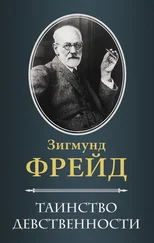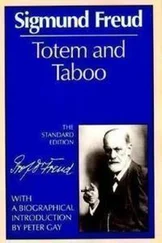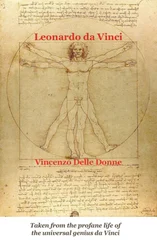The vulture phantasy of Leonardo still absorbs our interest. In words which only too plainly recall a sexual act ("and has many times struck against my lips with his tail"), Leonardo emphasizes the intensity of the erotic relations between the mother and the child. A second memory content of the phantasy can readily be conjectured from the association of the activity of the mother (of the vulture) with the accentuation of the mouth zone. We can translate it as follows: My mother has pressed on my mouth innumerable passionate kisses. The phantasy is composed of the memories of being nursed and of being kissed by the mother.
MONA LISA
A kindly nature has bestowed upon the artist the capacity to express in artistic productions his most secret psychic feelings hidden even to himself, which powerfully affect outsiders who are strangers to the artist without their being able to state whence this emotivity comes. Should there be no evidence in Leonardo's work of that which his memory retained as the strongest impression of his childhood? One would have to expect it. However, when one considers what profound transformations an impression of an artist has to experience before it can add its contribution to the work of art, one is obliged to moderate considerably his expectation of demonstrating something definite. This is especially true in the case of Leonardo.
He who thinks of Leonardo's paintings will be reminded by the remarkably fascinating and puzzling smile which he enchanted on the lips of all his feminine figures. It is a fixed smile on elongated, sinuous lips which is considered characteristic of him and is preferentially designated as "Leonardesque." In the singular and beautiful visage of the Florentine Monna Lisa del Giocondo it has produced the greatest effect on the spectators and even perplexed them. This smile was in need of an interpretation, and received many of the most varied kind but none of them was considered satisfactory. As Gruyer puts it: "It is almost four centuries since Monna Lisa causes all those to lose their heads who have looked upon her for some time." [50] Seidlitz: Leonardo da Vinci, II Bd., p. 280.
Muther states: [51] Geschichte der Malerei, Bd. I, p. 314.
"What fascinates the spectator is the demoniacal charm of this smile. Hundreds of poets and writers have written about this woman, who now seems to smile upon us seductively and now to stare coldly and lifelessly into space, but nobody has solved the riddle of her smile, nobody has interpreted her thoughts. Everything, even the scenery is mysterious and dream–like, trembling as if in the sultriness of sensuality."
The idea that two diverse elements were united in the smile of Monna Lisa has been felt by many critics. They therefore recognize in the play of features of the beautiful Florentine lady the most perfect representation of the contrasts dominating the love–life of the woman which is foreign to man, as that of reserve and seduction, and of most devoted tenderness and inconsiderateness in urgent and consuming sensuality. Müntz [52] l. c. p. 417.
expresses himself in this manner: "One knows what indecipherable and fascinating enigma Monna Lisa Gioconda has been putting for nearly four centuries to the admirers who crowd around her. No artist (I borrow the expression of the delicate writer who hides himself under the pseudonym of Pierre de Corlay) has ever translated in this manner the very essence of femininity: the tenderness and coquetry, the modesty and quiet voluptuousness, the whole mystery of the heart which holds itself aloof, of a brain which reflects, and of a personality who watches itself and yields nothing from herself except radiance…." The Italian Angelo Conti [53] A. Conti: Leonardo pittore, Conferenze Fiorentine, l. c. p. 93.
saw the picture in the Louvre illumined by a ray of the sun and expressed himself as follows: "The woman smiled with a royal calmness, her instincts of conquest, of ferocity, the entire heredity of the species, the will of seduction and ensnaring, the charm of the deceiver, the kindness which conceals a cruel purpose, all that appears and disappears alternately behind the laughing veil and melts into the poem of her smile…. Good and evil, cruelty and compassion, graceful and cat–like, she laughed…."
Leonardo painted this picture four years, perhaps from 1503 until 1507, during his second sojourn in Florence when he was about the age of fifty years. According to Vasari he applied the choicest artifices in order to divert the lady during the sittings and to hold that smile firmly on her features. Of all the gracefulness that his brush reproduced on the canvas at that time the picture preserves but very little in its present state. During its production it was considered the highest that art could accomplish; it is certain, however, that it did not satisfy Leonardo himself, that he pronounced it as unfinished and did not deliver it to the one who ordered it, but took it with him to France where his benefactor Francis I, acquired it for the Louvre.
Let us leave the physiognomic riddle of Monna Lisa unsolved, and let us note the unequivocal fact that her smile fascinated the artist no less than all the spectators for these 400 years. This captivating smile had thereafter returned in all of his pictures and in those of his pupils. As Leonardo's Monna Lisa was a portrait we cannot assume that he has added to her face a trait of his own so difficult to express which she herself did not possess. It seems, we cannot help but believe, that he found this smile in his model and became so charmed by it that from now on he endowed it on all the free creations of his phantasy. This obvious conception is, e.g., expressed by A. Konstantinowa in the following manner: [54] l. c. p. 45.
"During the long period in which the master occupied himself with the portrait of Monna Lisa del Gioconda, he entered into the physiognomic delicacies of this feminine face with such sympathy of feeling that he transferred these creatures, especially the mysterious smile and the peculiar glance, to all faces which he later painted or drew. The mimic peculiarity of Gioconda can even be perceived in the picture of John the Baptist in the Louvre. But above all they are distinctly recognized in the features of Mary in the picture of St. Anne of the Louvre."
But the case could have been different. The need for a deeper reason for the fascination which the smile of Gioconda exerted on the artist from which he could not rid himself has been felt by more than one of his biographers. W. Pater, who sees in the picture of Monna Lisa the embodiment of the entire erotic experience of modern man, and discourses so excellently on "that unfathomable smile always with a touch of something sinister in it, which plays over all Leonardo's work," leads us to another track when he says: [55] W. Pater: The Renaissance, p. 124, The Macmillan Co., 1910.
"Besides, the picture is a portrait. From childhood we see this image defining itself on the fabric of his dream; and but for express historical testimony, we might fancy that this was but his ideal lady, embodied and beheld at last."
Herzfeld surely must have had something similar in mind when stating that in Monna Lisa Leonardo encountered himself and therefore found it possible to put so much of his own nature into the picture, "whose features from time immemorial have been imbedded with mysterious sympathy in Leonardo's soul." [56] M. Herzfeld: Leonardo da Vinci, p. 88.
Let us endeavor to clear up these intimations. It was quite possible that Leonardo was fascinated by the smile of Monna Lisa, because it had awakened something in him which had slumbered in his soul for a long time, in all probability an old memory. This memory was of sufficient importance to stick to him once it had been aroused; he was forced continually to provide it with new expression. The assurance of Pater that we can see an image like that of Monna Lisa defining itself from Leonardo's childhood on the fabric of his dreams, seems worthy of belief and deserves to be taken literally.
Читать дальше









